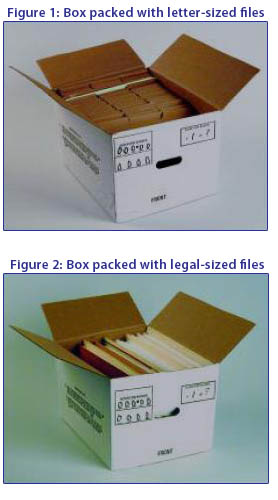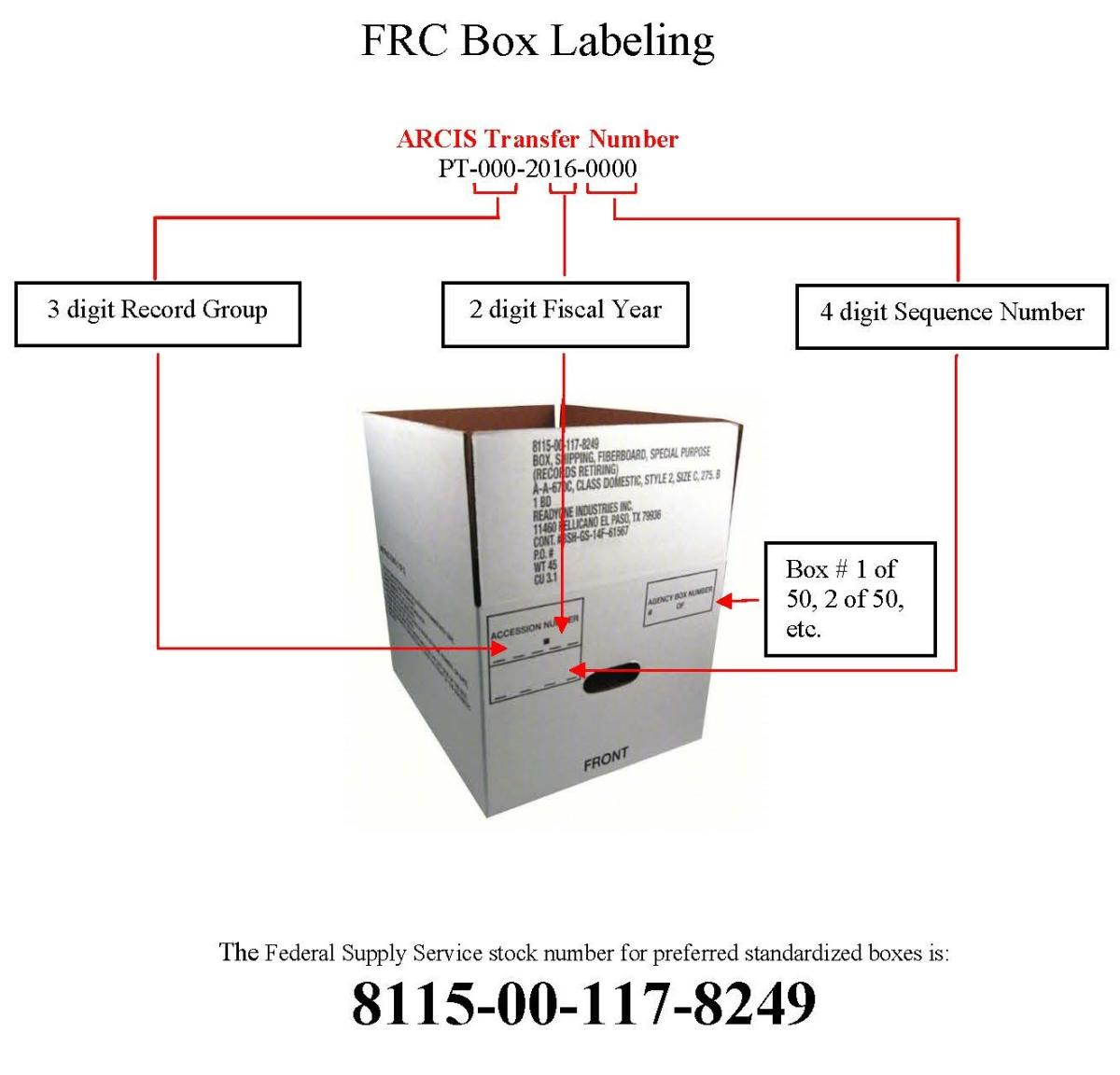
Agency Records from Transfer through Disposition
- Please see OMB M-23-07 and/or your agency Records Officer for additional information.
- If you have questions or require clarification about the requirements of OMB/NARA M-19-21 or the exception process, please visit https://www.archives.gov/records-mgmt/policy/digitization for more information.
- Transferring Records to a Federal Records Center
- Schedule Changes
- Disposition of Temporary Records
- Disposition of Permanent Records (Annual Move)
Transferring Records to a Federal Records Center
There are seven steps required in transferring records to a Federal Records Center.
- Organize The Records
- Pack The Records
- Prepare the Records Transfer (SF135)
- Submit the Records Transfer (SF135)
- Approval of the Records Transfer
- Pack The Pallets
- Coordinate Shipment
1. Organizing The Records
Separate records having the same disposition authority code into series by records schedule item number and cutoff date. Each series will be handled as a separate transfer consisting of at least one box and normally only one closing year date.
A series is a block of records having the same disposition authority and the same disposition date.
2. Pack the Records
• Leave a 1-to-2-inch space in each box to allow ease of reference.
• Do not put packing material inside the box.
• Mixed media (e.g., computer diskettes, microfilm, or videocassettes) cannot be stored in the same environment as paper records. Textual and electronic media must be in separate transfers.
• The transfer number and box numbers must be clearly written with a wide-tip black marker at least 1 inch high on the box. If tape is used to seal the box, do not write the transfer number over the tape.


3. Prepare the Records Transfer (SF135)
The ARCIS - Archives and Records Centers Information System is the most secure method for submitting records transfer requests to the Federal Records Centers.
Review the online tutorial – Module 5 to learn how to create a new Records Transfer in ARCIS.
Agencies that have not yet deployed ARCIS can submit the transfer using the PDF version of the SF135.
There is a surcharge on all non-ARCIS Portal transfers. Please check with the Agency Records Officer to verify procedures for transfer submission.
Data Fields for the Records Transfer (SF135)
- Item 1: Enter the name and address of the FRC where the records are to be sent.
- Item 2: Enter the name of the transferring agency official. To expedite and improve the transfer process, FRCs will accept SF 135s without original signatures. Please note that agency internal procedures may require signatures. Please contact the Agency Records Officer for procedural requirements.
- Item 3: Provide the name, office, business telephone number (including area code), and e-mail address of the person to contact about the records.
- Item 4: Completed by the FRC.
- Item 5: Provide the complete address of the transferring office. If records come from one office, but the SF 135 should be sent to a different office, please include BOTH addresses. Specify where the approved SF 135 should be sent, and where the final SF 135 should be sent (receipt copy).
- Item 6: Once a transfer is approved by the FRC the transfer number is cited in Item 6 and must be marked on the boxes The ARCIS transfer number is a unique 4-part number ("PT-XXX-YYYY-####" where XXX is the record group expressed as a 3-digit number, YYYY is the Fiscal Year, and #### is a system generated number). Legacy (pre-ARCIS) transfers display in three parts: PXXX-YY-####, where P is the facility code, XXX is the record group, YY is the Fiscal Year, and #### is a system-generated number).
- Item 6(d): For transfer and billing purposes, a standard-size box equals one cubic foot. Enter the total number of boxes included in this transfer. If the records do not fit in a standard records center box, leave this column blank, add the dimensions of the container to item 6(f), and contact the FRC General Transfer address to verify acceptance.
- Item 6(e): Enter the inclusive range of numbers (e.g., 1-30).
- Item 6(f): Describe the records in sufficient detail to allow FRC staff to verify compliance with the records schedule. The series description can be found in the Records Control Schedule or the General Records Schedule. A complete series description includes the series title and inclusive start and end dates of the records.
- Include the organizational component that created the records if the component is other than that described in item 5.
- Indicate in this section if the series of records is subject to the Privacy Act. Since SF 135s are public records, information included on SF 135s (including folder title lists) should not contain National Security Classified information or information restricted by exemption B6, the Freedom of Information Act.
- Permanent records, unscheduled records, or records with disposition instructions requiring sampling must be submitted with a detailed folder listing for each box in item 6(f) (if space permits) or as an attachment. If the SF 135 is being submitted via ARCIS, the folder listing can be attached to the transfer in the portal. If the SF135 is submitted via email, the folder listing can be sent as an email attachment.
- Special description requirements apply to certain records and should be stated in item 6(f):
- Stratified Report Invoicing: For agencies participating in Stratified Report Invoicing, a caret (^) followed by a valid two-digit charge code must be placed at the beginning of the series description.
- Site Audit Records: State "GAO Site Audit" if the records have been so designated by the Government Accountability Office, and indicate whether the site audit records pertain to Native Americans.
- Non-paper-based and special format records: These can include records such as microfilm, engineering drawings (because of their special format), electronic media, etc. Include the format type in 6(f) (see information on specific codes for non-textual record types).
- Item 6(g): Restrictions
- If the records pertain to National Security Information, this section must be completed using one of the three National Security Classification codes (C=Confidential, S=Secret, or T=Top Secret). Please note that the codes Q, R, or W (listed on the back of the SF 135) should no longer be used. If a National Security Classification is designated, the records must be identified if they are designated as Code E (Restricted Data or Formerly Restricted Data). For further information, please see EO 12356 (http://www.archives.gov/federal-register/codification/executive-order/12356.html), later amended by EO 13292. Only the Washington National Records Center at Suitland can store classified records. Controlled Unclassified Records (CUI) requiring enhanced storage must be submitted to either San Bruno (San Francisco), Kansas City, or the WNRC.
- If there are no special restrictions, either enter code N or leave this section blank. In this case, the default restriction (restricted to authorized agency users and researchers) will apply.
- Item 6(h): Cite the appropriate schedule identifier and item number from the agency records schedule or the General Records Schedule (GRS). If records are unscheduled, please insert "pending" and cite the schedule, the item number, and the date the schedule was submitted to NARA. Also indicate in this section if the records are subject to extended retention, commonly known as a "freeze" on destruction. The "freeze code" is a three-letter designation created by FRC staff to identify the freeze pertinent to the records.
- Item 6(i): Follow the instructions on the records schedule to compute the disposition date. Because disposal is accomplished in quarterly cycles (i.e., January, April, July, and October), advance the date to the beginning of the next calendar quarter to obtain the actual date of disposal. For example, if the ending date of records is September 2006, and the retention period is three years, then the disposal date will be October 2009. Permanent records are offered to the National Archives on an annual basis; no month is required in the disposition date field.
- Item 6(j), 6(k), 6(l), and 6(m) are completed by FRC staff.
4. Submit the Records Transfer (SF 135)
Once all required fields have been completed, submit the transfer to the FRC.
Users submitting the transfer in ARCIS will see their submitted transfer in the FRC Workspace area in ARCIS.
Users submitting the transfer outside of ARCIS using an SF135 form should send it via email to the general transfer mailbox for the appropriate FRC.
5. Approval of the Records Transfer (SF135)
The FRC Transfer Team will review and either approve or return the records transfer for clarification within 10 working days.
Upon approval, the FRC will email a copy of the approved SF135 to the agency contact.
Place a printed copy of the approved SF 135 in box #1 of the transfer. If the boxes or other containers are sealed and must not be opened by NARA staff, place a copy of the SF135 in an envelope securely taped to the outside of box #1.
It is the agency’s responsibility to retain a detailed inventory listing for each box. It is therefore strongly recommended to include a copy of the detailed inventory in box #1.
Once approved, the shipment of the boxes can be coordinated with the FRC Transfer Team.
6. Pack the Pallets
Local FRCs differ slightly regarding the stacking of pallets and the preferred order of boxes on pallets. Please contact the FRC Transfer Team to confirm proper box order. Pallets should be securely banded with shrink-wrap, steel, plastic, or cord strapping before shipping.
7. Coordinate Shipment
Agencies are urged to arrange for the shipment of their records within 90 days after receipt of the approved records transfer request. Please advise the FRC Transfer Team if the transfer cannot be made within this period.
Agencies are responsible for covering the costs of shipping their records to FRCs. Records can be shipped using the U.S. Postal Service, commercial carrier, common carrier (on pallets), or by agency courier. Shipments of 25 boxes or more must be palletized. For large shipments of 50 boxes or more, please contact the FRC Transfer Team to schedule a delivery date, and instruct the commercial carrier to contact the FRC 24 hours before delivery.
Shipments that require extensive remedial effort resulting from (but not limited to) pallets out of order, records in oversized, damaged, or improperly taped/marked boxes, or without an approved records transfer will have additional costs billed to the sending agency.
Upon receipt of the shipment, the FRC will email a copy of the SF135.